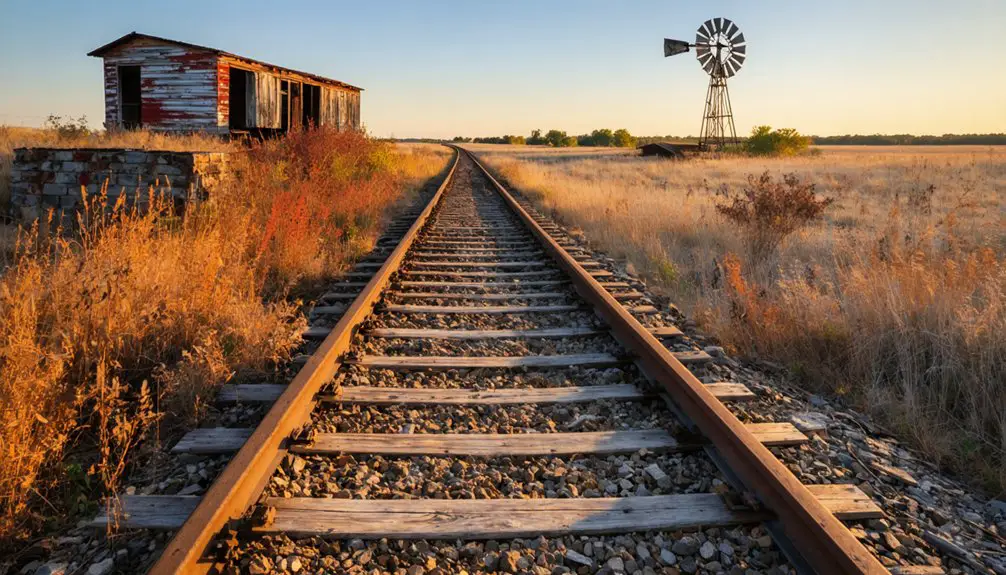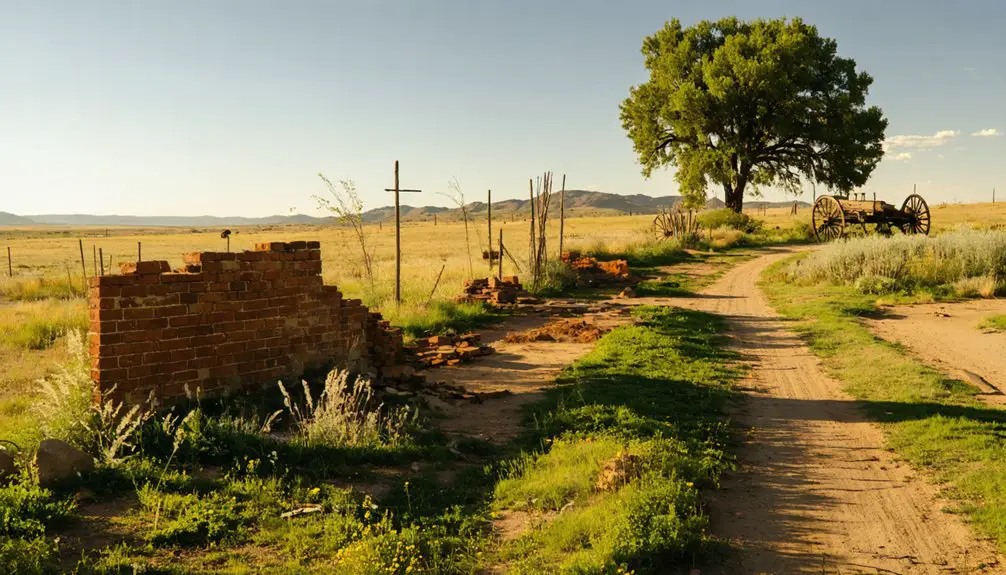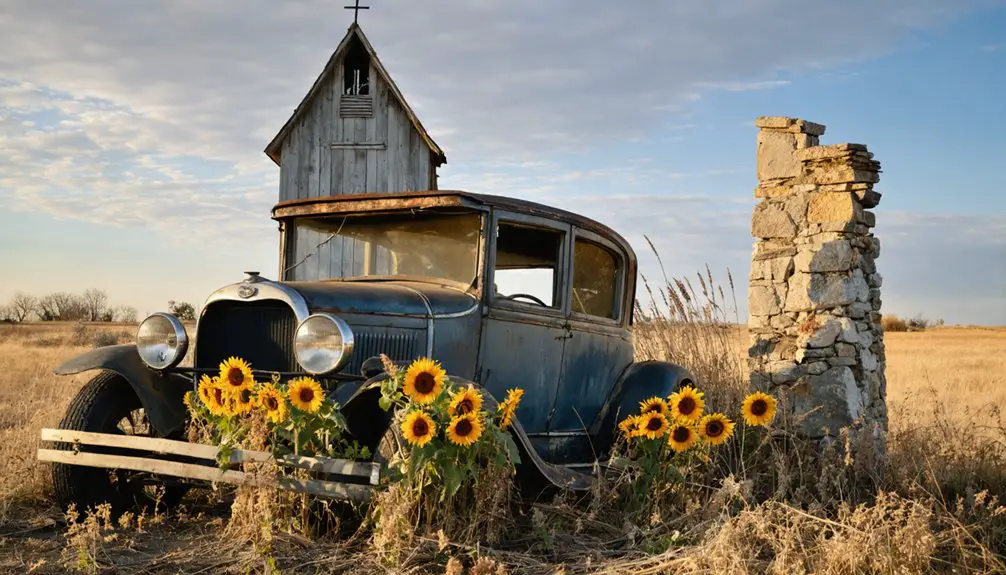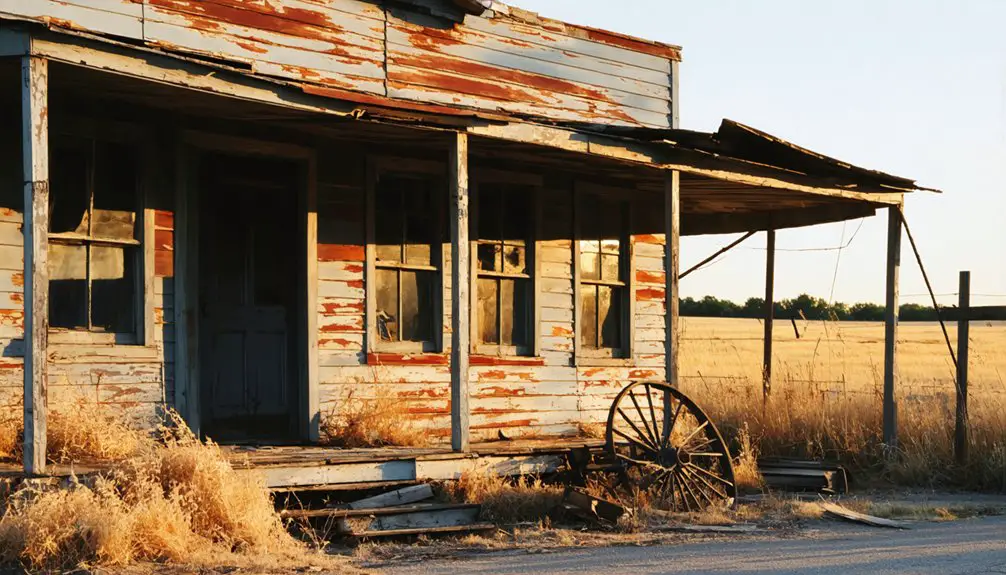You’ll find Silver City‘s ghostly remnants two miles north of Tuttle, Oklahoma, where this frontier settlement thrived from 1889 until the 1950s. The town began as a bustling stop along the Chisholm Trail, complete with J.D. Lindsay’s trading post, Cornett’s hotel, and a crucial blacksmith shop. When the Rock Island Railroad bypassed Silver City, residents relocated seven miles west to establish Minco in 1890. Today, the cemetery stands as a monument to this remarkable frontier community’s spirit.
Key Takeaways
- Silver City was established in 1889 near Tuttle, Oklahoma, serving as a trading post and rest stop along the Chisholm Trail.
- The town featured a diverse economy centered around silver mining, with Mexican residents comprising 58% of the population.
- In 1890, residents relocated the entire town seven miles west, including moving buildings, and renamed it Minco.
- The town’s decline was primarily caused by the Rock Island Railroad bypassing it, forcing residents to move to rail-connected communities.
- Unlike typical ghost towns, Silver City maintained its church and fire department until the 1950s before its eventual abandonment.
Early Settlement and Town Origins
Located just two miles north of present-day Tuttle, Oklahoma, Silver City emerged as a small but essential settlement in 1889 along the historic Chisholm Trail.
You’ll find that early settlement patterns centered around the Sumerian River, which provided reliable water access vital for the town’s survival and growth. Unlike the Idaho town of the same name which saw peak populations of 2,500, this settlement remained relatively small throughout its existence.
The town’s early commerce revolved around J.D. Lindsay’s store, where Will Sawyer helped manage daily operations. The store became a significant trading post for local Indigenous peoples.
Cornett’s hotel and Billie Nelson’s blacksmith shop formed the heart of the business district, while Mrs. Dr. John Shirley’s residence sat east of the store.
These establishments served both locals and travelers making their way to Ingalls or Kansas.
The town’s strategic position near the Chisholm Trail made it a natural rest stop for cattle drivers and merchants alike.
Life in 1880s Silver City
You’d find a bustling business district in 1880s Silver City, where Mexican and Anglo merchants operated side-by-side serving the town’s diverse population.
The local economy thrived on mining-related commerce, with businesses like general stores, boarding houses, and saloons catering to workers from Chihuahua Hill and surrounding neighborhoods. The town’s transformation from its mining roots can still be seen in its historic downtown today. Census records show that Mexican residents comprised 58% of Silver City’s population during this period.
Religious institutions, particularly La Capilla chapel and Little Flower Church, served as essential community hubs where residents gathered for both spiritual services and social events.
Daily Business Operations
While silver mining formed the backbone of Silver City’s economy in the 1880s, the town’s daily business operations extended far beyond the mines themselves.
You’d find a bustling network of businesses supporting the mining techniques and seasonal labor patterns that defined the community. Local shops supplied essential tools and goods, while freighters moved critical supplies in and out of town using horse-drawn wagons.
You could see craftsmen like silversmiths practicing their trade, adobe makers constructing buildings, and various service providers meeting the town’s needs. Many families adapted to the rhythm of the mines, combining wage labor with home-based businesses. The dual wage system meant Mexican workers often earned less than white workers for the same jobs.
The town’s infrastructure, though basic, supported these operations with water systems, fire protection, and local law enforcement, creating a self-sustaining economic ecosystem that kept Silver City thriving.
Social Life and Services
Despite its modest size, Silver City fostered a vibrant social fabric woven from diverse threads of community life in the 1880s. You’d find spiritual connections at the Baptist church, where community gatherings went beyond Sunday services to strengthen local bonds. The town’s strategic location along the Chisholm Trail crossing made it a crucial stopping point for weary travelers and commerce. The thriving apple and peach orchards along the Sumerian River made Silver City a hub for agricultural trade and community harvesting events.
The town’s social landscape offered unique experiences that shaped daily life:
- Mexican craftsmen selling handmade quirts to cowboys, adding cultural diversity
- Local orchards and cattle operations bringing families together for shared labor
- The convenience store and church serving as hubs for news and fellowship
- Legendary whiskey trade creating distinctive social spaces
- Volunteer fire department demonstrating neighbors helping neighbors
These social threads created a close-knit community where cattlemen, trail drivers, and local families relied on each other while sharing essential resources like creek water and grazing lands.
Key Community Buildings and Services
Although Silver City has largely faded into ghost town status, several key structures remain as evidence of its former liveliness.
You’ll find one active church building standing as the town’s sole operational religious site, while the ruins of a Baptist church succumb to nature’s reclamation. A volunteer fire department continues serving the sparse population, providing essential emergency services to the area. Like many ghost towns from the Gold Rush era, these buildings represent a period of prosperity followed by decline. Oklahoma’s history includes approximately two thousand ghost towns across the state, each telling a similar story of rise and fall.
The community’s decline accelerated after Highway 51’s realignment in the late 1950s, triggering major infrastructure changes that sealed the town’s fate.
The abandoned convenience store, once a hub of daily commerce, now stands as a silent reminder of busier days. Basic services gradually disappeared as residents moved away – from law enforcement to postal operations – leaving only traces of Silver City’s more vibrant past.
Notable Residents and Families
Several prominent families shaped Silver City’s history, but none left a more lasting impression than the Daltons, who arrived in Indian Territory in 1882.
The Dalton legacy intertwined law enforcement and outlaw activities, with Julia Johnson’s marriage into the family adding another layer to their complex story. The gang’s ambitious plan to rob two banks simultaneously demonstrated their determination to surpass Jesse James’s notorious reputation.
While records of other residents remain limited, you’ll find these fascinating details about Silver City’s notable inhabitants:
- The Dalton family had 13 children who influenced both sides of the law
- Julia Dalton’s family residence served as a hideout during the gang’s activities
- Enos Spille maintained connections between Silver City and neighboring towns
- Local farming and ranching families formed the backbone of the community
- Church leaders and fire department volunteers served essential community roles
The Railroad’s Impact on Silver City

While Silver City once thrived along historic cattle trails, its fate took a decisive turn when major railroad companies bypassed the settlement in the late 19th century.
You’ll find the railroad bypass proved catastrophic for the town’s survival, as the Chicago, Kansas and Nebraska Railway chose to build tracks through Minco in 1890 instead.
The economic decline was swift and irreversible.
As rail lines stretched through neighboring towns like Chickasha, Ninnekah, and Rush Springs, Silver City’s residents faced a stark choice: relocate or risk isolation.
Many chose to follow the railroad’s path, abandoning their homes for opportunities in rail-connected communities.
Economic Activities and Local Trade
Despite its eventual ghost town status, Silver City emerged as a dynamic mining hub where British-backed silver operations drove the local economy.
Before falling silent, Silver City thrived as a bustling British-funded mining center that transformed silver into prosperity.
You’ll find that advanced mining technology set this town apart, helping it weather market fluctuations better than most. The Poorman Mine‘s silver even earned international acclaim, winning gold at the 1867 Paris Exposition.
- Trading patterns centered around crucial mining supplies and equipment
- Local merchants, saloons, and boarding houses served the mining community
- Assay offices and repair shops supported the mining operations
- Transport services kept silver flowing to market
- Postal services operated until 1943, maintaining essential connections
The town’s economy adapted to the ebb and flow of miners, with businesses rising to meet their needs.
British investment sustained operations longer than in comparable towns, though ultimately couldn’t prevent the settlement’s decline.
The Great Move to Minco

When the Chicago, Rock Island & Pacific Railroad extended its tracks to the Chisholm Trail in 1890, Silver City’s residents faced a pivotal decision. Rather than watch their community fade into obscurity, they demonstrated remarkable community resilience by relocating their entire town seven miles west to meet the railroad expansion.
You can imagine the determination it took as J.C. Malcom and his neighbors hauled entire buildings across the untamed prairie, crossing Store Creek, Beaver Creek, and Boggy Creek. Their repeated journeys carved out a new road through the territory.
While the old schoolhouse stood abandoned as a lonely sentinel of the past, the relocated town – renamed Minco – quickly flourished at its new location. By July 4, 1890, they’d established an official townsite, marking a new chapter in their community’s story.
Comparing Silver City to Other Oklahoma Ghost Towns
Among Oklahoma’s numerous ghost towns, Silver City stands apart through its distinctive agricultural heritage and gradual decline linked to highway changes rather than resource depletion.
While other ghost towns vanished due to mining exhaustion or prohibition laws, Silver City’s economic contrasts reveal a more sustainable foundation built on farming and the Sumerian River’s reliable water supply.
- Unlike boom-and-bust mining towns, Silver City enjoyed steady growth through cattle and orchards.
- While liquor towns died with statehood in 1907, Silver City thrived until the 1950s highway relocation.
- Most ghost towns have vanished completely, but Silver City retains its church and fire department.
- Other towns drowned under reservoirs, while Silver City remains accessible.
- Unlike Route 66 towns that died from interstate bypasses, Silver City’s decline came from local road changes.
What Remains Today

Ten scattered structures mark the physical remnants of Silver City today, offering glimpses into this once-thriving Oklahoma farming community.
You’ll find an abandoned convenience store, a fire department building, and a church among the surviving structures. A machine shop and approximately 10 homes complete the town’s remaining footprint.
While most abandoned structures show signs of neglect, they tell the story of community survival through a handful of resilient residents.
Even in decay, these weathered buildings speak volumes about the determined few who refuse to let go.
About 50 people still call Silver City home, living primarily in the remaining houses scattered across this rural landscape.
Located between Tulsa and Stillwater, the settlement maintains minimal services through its fire department, though its operational status remains uncertain.
The church and machine shop stand as evidence to the town’s agricultural roots.
Legacy in Oklahoma’s Frontier History
You’ll find Silver City’s fate was sealed when the Rock Island Railroad chose to bypass it, leading to a swift exodus of residents and businesses to the newly established town of Minco.
Though Silver City’s physical structures have vanished, its memory endures as a symbol of how railroad decisions shaped Oklahoma’s frontier development.
The town’s story lives on through its cemetery and through local families who still share tales of this once-bustling Chisholm Trail stop.
Railroad’s Decisive Impact
The absence of railroad access proved fatal for Silver City’s survival, as the crucial rail lines of the 1890s bypassed the once-promising frontier settlement.
When the Chicago, Kansas and Nebraska Railway reached nearby Minco in 1890, it triggered a decisive shift in the region’s development pattern.
Here’s how railroad connectivity transformed the area and sealed Silver City’s fate:
- Major population migration flowed from Silver City to railroad-connected towns like Minco
- Rock Island Railroad’s expansion made Chickasha a crucial commercial hub
- Rail stops attracted new businesses, warehouses, and settlers
- Transportation costs plummeted along rail routes
- The old stagecoach and cattle trail economy couldn’t compete with rail efficiency
Today, Silver City’s cemetery stands as the primary reminder of a community that time and tracks left behind.
Community Memory Lives On
While Silver City’s physical structures have largely vanished, its legacy endures through rich oral traditions, archaeological remnants, and cultural imprints that shape Oklahoma’s frontier narrative.
You’ll find community narratives woven with tales of outlaw hideouts in mysterious caves and stories of Mexican families crafting stock whips for passing cowboys. Local historical folklore preserves memories of quality bootleg whiskey and essential stops along the Chisholm Trail.
Though only the cemetery and scattered ruins remain today, relic hunters continue to uncover artifacts that tell of frontier life.
Silver City’s story lives on through volunteer organizations and nearby residents who maintain its memory, making it more than just one of Oklahoma’s two thousand ghost towns – it’s a reflection of the untamed spirit of the American frontier.
Frequently Asked Questions
Were There Any Major Crimes or Law Enforcement Incidents in Silver City?
You won’t find official crime statistics or major law enforcement incidents documented, though bootlegging and the outlaw cave suggest some criminal activity. Most stories remain as unverified local tales.
Did Native American Tribes Have Any Significant Interactions With Silver City?
Over 40% of early ranch hands were Native American. You’ll find tribal relations were significant, with Native herders preferred by cattlemen since Comanche raiders specifically targeted white settlers for attacks.
What Was the Average Land Price for Property in Silver City?
You’ll find land values vary widely, but current property trends show around $1,826 per acre based on a recent 230-acre listing. Historical prices aren’t well-documented for accurate averages.
Were There Any Documented Natural Disasters That Affected Silver City?
You won’t find any documented flood events or drought impact affecting the town in historical records. While Oklahoma faced natural disasters, there’s no evidence of specific catastrophes hitting this settlement.
Did Any Famous Outlaws or Historical Figures Pass Through Silver City?
While whispers of outlaws echo through cave hideouts, you won’t find documented outlaw sightings or famous figures in Silver City’s records – just cowboys driving cattle along the Chisholm Trail’s dusty path.
References
- https://en.wikipedia.org/wiki/List_of_ghost_towns_in_Oklahoma
- https://www.okhistory.org/publications/enc/entry?entry=GH002
- https://www.redbookmag.com/life/g34381869/ghost-towns-in-america/
- https://caddopublicationsusa.com/2016/05/01/forgotten-landmark-site-of-silver-city-tuttle-oklahoma/
- https://okmag.com/blog/a-ghostly-site/
- https://www.britannica.com/place/Silver-City-ghost-Idaho
- https://www.youtube.com/watch?v=2nPCW7v213I
- https://www.townofsilvercity.org/329/About-Silver-City
- https://esirc.emporia.edu/bitstream/handle/123456789/2565/Shutt II 1974.pdf?sequence=1
- https://www.silvercitymuseum.org/604/Timeline-History



